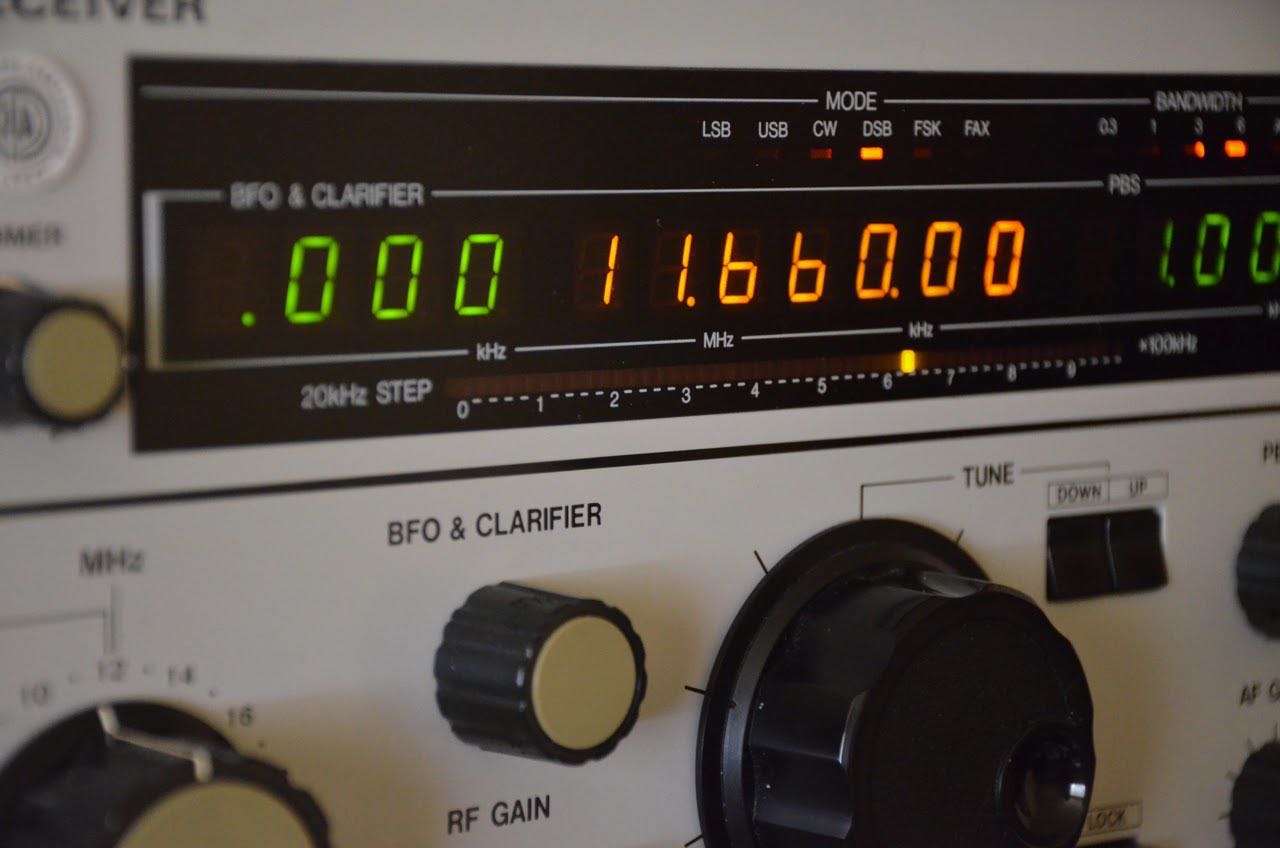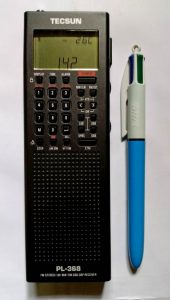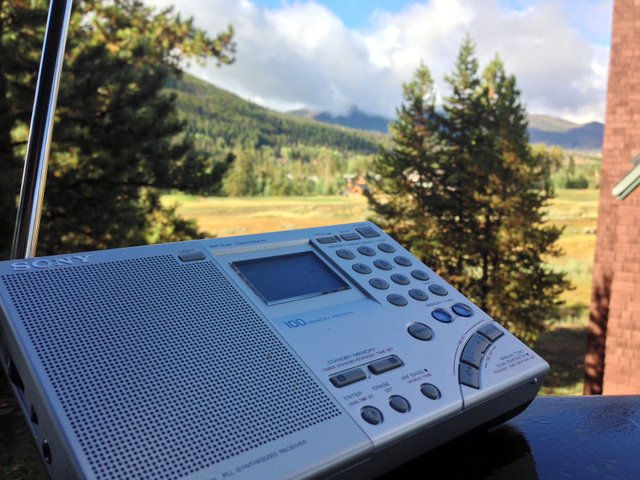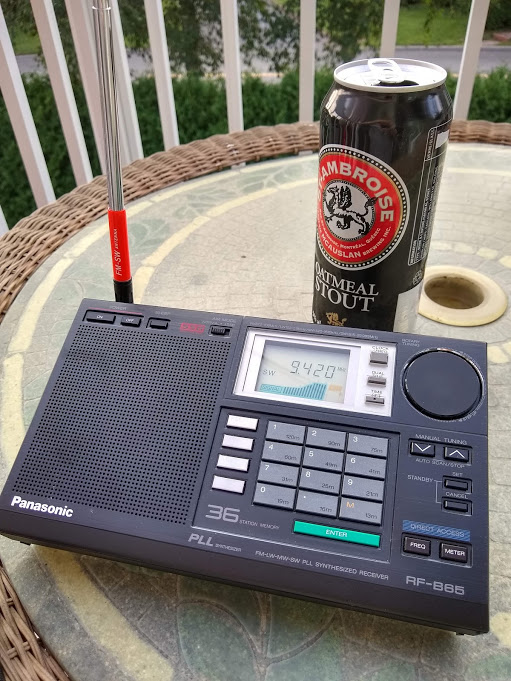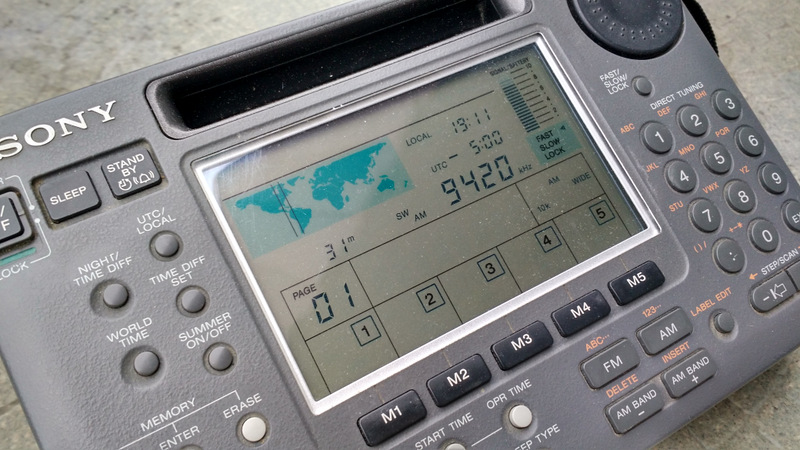
Perú le canta a las Américas (Peru Sings To the Americas)
Date/Time: Thursday, July 29th, 0300-0400 UTC**
**(Wednesday July 28 2200-2300 Lima Time)
WRMI 5800 kHz
In honor of the bicentennial of Peru’s independence, a special hour of Peruvian music hosted by Luis Alejandro Vallebueno with guests Estefania Rivera and “Uncle Bill” Tilford will air on WRMI, which is graciously sponsoring the program. It will be in Spanish and directed towards Central and South America, but the back end of the transmission should be listenable in much of North America. The music will be a combination of world-famous artists and others probably not known outside of Peru. There will also be some items regarding history, customs and shortwave in Peru.
Monthly Archives: July 2021
Radio Waves: Baseball Before Radio, VOA Ends Bangla on FM & SW, Brookmans Park Close to 100 Years, and Ireland National Shortwave Club on Zoom
Radio Waves: Stories Making Waves in the World of Radio
Because I keep my ear to the waves, as well as receive many tips from others who do the same, I find myself privy to radio-related stories that might interest SWLing Post readers. To that end: Welcome to the SWLing Post’s Radio Waves, a collection of links to interesting stories making waves in the world of radio. Enjoy!
Many thanks to SWLing Post contributors Tom Daly, David Iurescia, Dave Porter, and the Southgate ARC for the following tips:
Before There Was Radio: How Baseball Fans Followed Their Favorite Teams, 1912-1921 (SABR Century Research Committee)
If you were a major-league baseball fan in the 1910s, you were living at a time before commercial radio had come along. With no way to listen to the play-by-play at home (and no expectation that such a thing was even possible), you had to find other options when you wanted to know how your favorite team was doing. The best way, of course, was to go to the ballpark and watch the game in person, but not everyone could get the time off from work; there was no 40-hour workweek yet and putting in 50 or more hours a week was common in some jobs. And even if you had an understanding boss, there were still expenses to consider: By modern standards, tickets seemed cheap (even World’s Series seats ranged from 50 cents to $3), but keep in mind that the average worker’s salary was much less than what people earn today. For example, in 1915, the annual salary for teachers in most cities was less than $600,[1] and many other jobs paid no more than $700 a year.[2] Thus, attending a ballgame was reserved for special occasions.
Some fans who could not attend in person would go downtown and gather in front of the offices of the local newspaper, where they eagerly awaited the latest scores. The bigger cities often had a group of newspaper offices in close proximity to each other; in Boston and other large cities, this area was sometimes referred to as Newspaper Row. It became a place for fans to socialize, as everyone stood on the street in front of their favorite publication, hoping for good news about the game. When the newspaper received the latest scores from a telegrapher at the ballpark, a newsboy would write the information on a bulletin board, updating it every inning.[3] Some newspapers also had someone with a megaphone calling out the updates as they were received. In either case, the fans would cheer whenever the news was good, or express their disappointment when it wasn’t.[…]
VOA’s Bangla Service Ends Radio Broadcasts, Expands TV and Social Media Coverage (VOA)
Voice of America Bangla language service FM and shortwave radio transmissions officially end on July 17, 2021, after 63 years of serving Bangladesh and the Bangla-speaking Indian states of West Bengal, Tripure and Assam. Simultaneously, the service’s television and social media content will expand considerably, as these are platforms more heavily used by VOA Bangla’s 16 million weekly audience members.
“When VOA Bangla launched in January 1958, Bangladesh was known as ‘East Pakistan’ and it was a territory under martial law with no television or private radio,” said John Lippman, Acting VOA Programming Director. “VOA’s shortwave radio transmissions from outside the borders were a lifeline to the Bangla-speaking population for independent news and information.”
While the service’s shortwave radio audience is now less than one percent, VOA Bangla social media audiences have grown significantly in recent years. Engagement actions on the Twitter account have risen 54% over the previous year, while video views on Instagram are up 274% in the same period.
“Dozens of domestic television and radio stations compete for Bangla-speaking audiences, as well as an increasing number of digital sources,” Lippman noted. “As the demand for TV and online access to news in Bangladesh expands, VOA’s Bangla service program offerings need to be on the platforms its audience already is most active.”
“VOA Bangla radio broadcasts brought world events to its audiences since the days when radio was the primary news medium,” Acting VOA Bangla Service Chief Satarupa Barua told staff this month. “It was a staple in our upbringing, a household name. We will build on that reputation, increasing our presence on media that is now far more heavily used than short wave and medium wave radio.”
During the final days of its radio broadcasts, the service will broadcast retrospective programming, looking back at the changes in the country since 1958. “Because of our service’s history in Bangladesh, working at VOA has been the ‘dream job’ for many of us. With the coming changes, it will continue to be,” Barua added.
This change in radio programming will not affect broadcasts of “Lifeline”, a 30-minute daily radio program in the Rohingya language, spoken by Muslim refugees in Bangladesh who fled ethnic violence in Myanmar. Produced by the Bangla service, the program launched in July 2019.
Hatfield’s nearly 100-year-old broadcast station that revolutionised BBC radio (HertsLive)
Among its multiple accolades, Hertfordshire is home to one of the most important facilities in British broadcasting history – and it’s nearly 100 years old.
The Brookmans Park Transmitting station in Hatfield, Hertfordshire, was originally built by the BBC as the first of a network of regional dual transmitter stations, replacing the city-based ones from before.
The station has played a crucial part in the history of broadcasting in Britain. It was the first purpose-built twin transmitter station in the world that was capable of broadcasting two radio programmes simultaneously when it was completed in 1929.
The transmitter also played a role in the early development of television broadcasting.
This particular station was the first in the BBC’s adventurous scheme to bring existing radio reception to the whole of Britain.[…]
National Short Wave Listeners Club (Southgate ARC)
Ireland’s IRTS News report that meetings of the National Shortwave Club on Sunday evenings at 2000 on the Zoom platform will continue over the Summer months and they continue to attract around half of the membership of almost 120 most weeks.
A decision has been made to suspend the weekly Wednesday revision classes until it looks like an examination will be held within a reasonable time. Hopes are high that following next Thursdays Government announcement, an exam date will be published as soon as possible thereafter.
Interest in the new on-line classes which will begin in the autumn is already high and anyone interested is invited to reserve their place via email to ‘training at SWL.ie’
Do you enjoy the SWLing Post?
Please consider supporting us via Patreon or our Coffee Fund!
Your support makes articles like this one possible. Thank you!
Tecsun PL-368 to start shipping end of July via Anon-Co
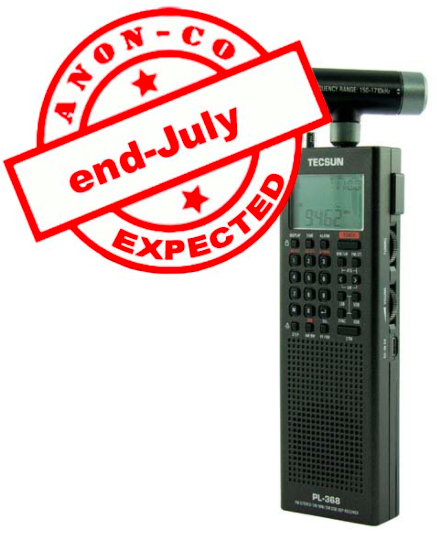 Many thanks to SWLing Post contributor, Gareth, who notes that Anon-Co will start selling the new Tecsun PL-368 by the end of July 2021.
Many thanks to SWLing Post contributor, Gareth, who notes that Anon-Co will start selling the new Tecsun PL-368 by the end of July 2021.
Click here to check out the product page at Anon-Co.
Also, check out Robert Gulley’s recent review and a review by Dan Robinson!
FTIOM & UBMP, July 18-24
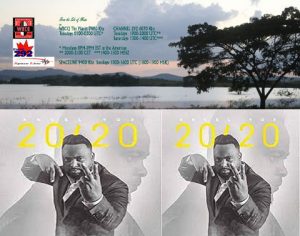

From the Isle of Music, July 18-24:
This week, our guest is Angel Yos, whose album 20/20 won the Bailable Fusión Latina category in Cubadisco 2020-2021.
The broadcasts take place:
1. For Eastern Europe but audible well beyond the target area in most of the Eastern Hemisphere (including parts of East Asia and Oceania) with 100Kw, Sunday 1500-1600 UTC on SpaceLine, 9400 KHz, from Sofia, Bulgaria (1800-1900 MSK)
2. For the Americas and parts of Europe, Tuesday 0000-0100 UTC on WBCQ, 7490 kHz from Monticello, ME, USA (Monday 8-9PM EDT in the US).
3 & 4. For Europe and sometimes beyond, Tuesday 1900-2000 UTC and Saturday 1200-1300 UTC on Channel 292, 6070 kHz from Rohrbach, Germany.
Our Facebook page is https://www.facebook.com/fromtheisleofmusic/
Our V-Kontakte page is https://vk.com/fromtheisleofmusic
Our Patreon page is https://www.patreon.com/tilford
Uncle Bill’s Melting Pot, July 18-24:
In episode 226, we enjoy music from Tunisia.
The transmissions take place:
1.Sunday 2200-2300 (6:00PM -7:00PM EDT) on WBCQ The Planet 7490 kHz from the US to the Americas and parts of Europe
2. Tuesday 2000-2100 UTC on Channel 292, 6070 kHz from Rohrbach, Germany for Europe.
3. Saturday 0800-0900 UTC on Channel 292, 9670 kHz from Rohrbach, Germany for Europe with a directional booster aimed eastward.
Our Facebook page is https://www.facebook.com/UncleBillsMeltingPot/
Our V-Kontakte page is https://vk.com/fromtheisleofmusic
Our Patreon page is https://www.patreon.com/tilford
Tecsun PL-368: An Everyman Review
Guest Post
The Tecsun PL-368: An Everyman Review
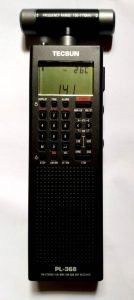
By Robert Gulley
I entitled this review an “Everyman” review because, while I am far from “normal” (just ask any of my friends!), I am not a hard-core SWL. I am a hard-core amateur radio operator perhaps, but only for the last decade(+). I have been casually listening to shortwave radio for about 50 yrs. So, my perspective on this radio comes from someone who cut his teeth on a Realistic DX-160 (still love those radios!), progressing through various desktop and portable radios, to three of my current favorites, the FRG-7, the Sangean 909X2, and the Sony 7600GR. Of course, this doesn’t count some vintage WWII-era radios and earlier, but they are favorites for other reasons.
Now, the purpose of this little reflection on equipment is to say all radios have their place in the pantheon of shortwave radios, and no one radio “does it all.” The Tecsun radio, I believe, fills a very specific niche in the radio world, and it is excellent for those purposes. It does not, however, rival other radios whose goals are different, such as ones designed around sound fidelity, digital signal processing, SDR capability etc.
What this radio does do is present a very capable radio in an ultra-small package, designed to fit easily for travel and for survival/emergency situations, or for armchair operation. That middle one may surprise you, so allow me to explain.
I have a previous model of this radio (GP-5/SSB still available) sold by CountyComm, which was modified from Tecsun’s stock production PL-365, to have features suitable for government use. This has become a rather popular radio for preppers because of those modifications. The idea behind this radio as a compact piece of kit for government embassy people was to have something which could be easily concealable, operated with one hand, and have a wide range of reception capabilities. Of course, good reception of shortwave, AM, and FM bands was considered a must. You can look at the CountryComm website to find out specific features of the modified units if interested, as that radio, or the PL-365, are not the subject of this review.
While not a real “prepper” myself, I was intrigued by the AM broadcast reception capabilities due to the plug-in ferrite antenna, and also liked the idea of the small footprint. In actual use I found the radio to be quite versatile, a good performer, but rather awkward to use as there was no quick way to get to specific frequencies, unless already programmed into a memory location. With no direct keyboard entry on the GP-5, going to random locations to channel surf was, for me, frankly a bit annoying.
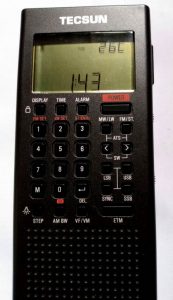 Enter the PL-368 which boasts a direct keyboard entry! Yes!! This one feature has taken the radio to a new level of performance which makes it a joy to use in this reviewer’s humble opinion. (Full disclosure, the unit I received for this review was provided by ANON-CO, and is the latest model after the recent firmware update incorporated by Tecsun. However, I have no other connection to ANON-CO or Tecsun, and my willingness to do the review is purely based on my previous purchase and experience with the CountyComm model.)
Enter the PL-368 which boasts a direct keyboard entry! Yes!! This one feature has taken the radio to a new level of performance which makes it a joy to use in this reviewer’s humble opinion. (Full disclosure, the unit I received for this review was provided by ANON-CO, and is the latest model after the recent firmware update incorporated by Tecsun. However, I have no other connection to ANON-CO or Tecsun, and my willingness to do the review is purely based on my previous purchase and experience with the CountyComm model.)
Despite having an unusual number of stormy days and nights here in the Midwestern U.S. recently, I have managed to enjoy some very productive listening opportunities with this little radio. For example, being an amateur radio operator, I appreciate the ability to listen in on the amateur frequencies now an again, and the recent ARRL Field Day afforded me the opportunity to really test out the radio’s USB/LSB reception capabilities, and its ability to dig out signals on a really crowded band. I was quite impressed both with its DSP and bandwidth capabilities and the reasonable clarity of the audio when tuning in various signals. Does it have the richness of audio that my Sangean 909X2 has? No, of course not. The speaker is much smaller in the PL-368, but it was quite listenable. Likewise, listening to various nets on 80 meters was quite acceptable with the built-in antenna, where noise and local interference are common gremlins on any radio.
For shortwave stations I found the radio to be quite sensitive just using the built-in antenna, which is key to portable listening. If I have to attach an external antenna, my mobility becomes limited, and I might as well just listen to one of my desktop radios. Some reception examples include: NHK World Radio 9560, Helliniki Radiophonia Voice of Greece 9420, WRMI relay of KSKO 89.5’s Paul Walker from McGrath Alaska on 7780 (beamed to east coast U.S., as well as on 7730 beamed to west coast, Hawaii, and South Pacific).
Of course, reception of CRI, Radio Havana Cuba, and numerous religious broadcasts were heard on all the usual places. I also listened to WWV signals at various locations, my go-to initial band reception check, as well as listening to HF aircraft broadcasts, military planes training on 11175 (USB), and maritime weather broadcasts. While I did not try digital mode reception such as FT8 with WSJT-X from the headphone jack, I have no doubt I would have been able to monitor these stations on various bands easily as the signals were immediately recognizable. The same holds true for CW reception.
Operational Notes
For a thoughtful, in-depth review of many technical aspects of this radio Dan Robinson has written an excellent piece on the PL-368, along with an updated review of the latest firmware’s effect on the radio. One aspect worth mentioning in my experience with this radio is that, unlike Dan, I did not find an issue with changing sensitivity when touching/holding the radio versus the radio standing on its own. Your mileage may vary, of course, so this goes in the “for what it’s worth” category. Maybe this issue has been resolved in later production runs? Or maybe my capacitance is running low and I need more electrolytes<grin>!
Like Dan, I found the SYNC detection of USB/LSB to be marginal at best, mostly making the signals harder to hear. On the upside, standard reception was quite good, and I did not experience significant fading most of the time.
Below are some of the hidden keyboard functions as listed, provided by Anna of ANON-CO, but I wanted to mention a feature I have either forgotten when using my GP5 CountyComm model, or which has been added (sorry, I don’t have access to the GP5 right now as it is packed away due to a recent move in progress). When “speed tuning” as I call it (turning the tuning dial quickly) with the “step” selected to the smallest increment on SW, what starts as increments of 10Hz will jump to 50Hz at a time after a few moments. This helps in trying to quickly latch on to a signal when increments of 10 are not necessary. The tuning will revert to 10Hz units when stopped for a few seconds.
Now for some undocumented features:
Switch between internal ferrite rod and whip on AM (MW & LW)
- Select the MW or LW band.
- Press and hold key ‘3’ for about 2 seconds.
When the display briefly shows “CH-5” this means that the device is set to MW/LW reception using the telescopic antenna. The display shows MW (or LW) and SW on the left side of the screen.
When the display briefly shows “CH-A” this means that the device is set to MW/LW reception using the internal ferrite antenna. The display shows only MW (or LW) on the left side of the screen.
Adjusting the maximum volume level
Select the frequency band, then press and hold key ‘7’ for 2 seconds until a number is displayed. At this moment, rotate the [ TUNING ] knob to adjust and press the key ‘7’ again to save and exit.
Firmware Version
In power-off mode, press and hold [ VF/VM ] for 0.5 seconds until all characters on the display are shown, then wait a few seconds until the firmware version is briefly displayed in the middle of the display.
Extend SW-range for European setting (1621-29999 kHz)
- In power-off mode, press and hold the [ 3 ] key to set the MW tuning steps to 9kHz.
- Select the SW band, and then press and hold the [ 5 ] key for 10 seconds to enable/disable the SW frequency extension. The starting point of the SW frequency range will become 1621 or 1711 kHz.
Some Nitpicks (There had to be some, right?!)
I wish the batteries were still standard AA units instead of the flat rechargeable unit. This is merely a personal preference, but as a radio designed for carry-anywhere usage, I like a radio to use batteries I can pick up anywhere if needed. I tend to use rechargeable AA and AAA batteries anyway, but I like knowing I can use ubiquitous alkaline batteries available at almost any store in a pinch.
I suspect the change was made to allow for more space for the direct keypad entry, and that is definitely a tradeoff I am willing to make!
On a related note, the recharging port uses the USB micro-b connector which I have found in cell phones, tablets, etc. to be a weak point as cables often seem to go bad, or the connector itself gets damaged. The larger mini-b would be my preference, but hey, again, that’s a nitpick.
Finally, the case does appear to be a little thin which makes me wonder how it might survive if dropped or knocked off a table. This is not a deal-breaker by any means, but something to consider when carrying it around or when packing it for a trip. It may survive quite well, but that’s a test I don’t want to try out just to see what happens.
For me, as a casual shortwave listener, I look for several things in a portable radio. I want true portability – if a so-called portable radio must be tethered to an external antenna to work decently, chances are I am not going to use it often – my various desktop models attached to outdoor antennas will always out-perform a portable. I also want a simplified layout of controls. I do not want to dig through menus, have be a contortionist to work the buttons/controls, or carry a manual with me to find out how to use the radio each time because the controls are confusing. I also want reasonable audio and clarity, or the ability to fine-tune a signal to minimize adjacent signals.
I find the PL-368 does for me what I want a portable to do and does it reasonably well. Is it the best portable out there? No. Is it a benchmark radio? No. But it is extremely portable, easily handled with just one hand, and its reception capabilities put it far above some other portables I have used. If you are looking for something which can easily fit into a pocket, bag, or purse, this radio is great. If you want a radio which performs well over a wide range of signals using the built-in antenna, this radio fills the bill. And if you want true USB/LSB, along with good bandwidth options in your portable, this is a great choice. Cheers!
(edit, July 23, 2021: an additional “hidden” feature to be included in the shipping version not included in this reviewed unit is an SSB calibration capability – definitely a plus! — Robert)
DSP technology is amazing, but maybe I’m just a legacy receiver kind of guy?
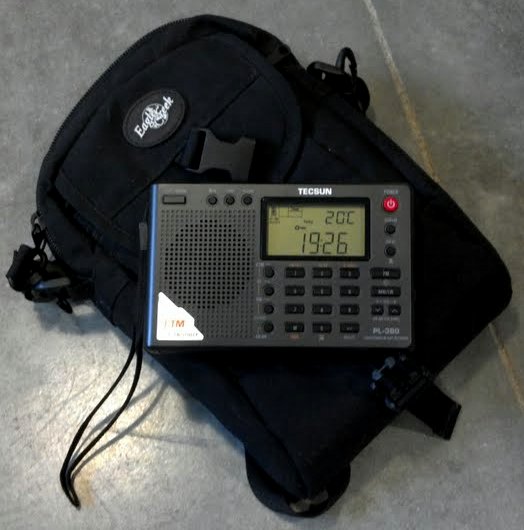
The PL-380 was one of the first portable DSP radios I purchased. It was mind-blowing at time of introduction and I still have it in my radio arsenal.
Without a doubt, DSP (Digital Signal Processing) technology has forever changed the portable receiver market in so many positive ways:
- It’s made portable radios more affordable for consumers
- It’s increased the profit margin for manufacturers
- It’s made features like SSB mode and variable filter width affordable
- When properly implemented, DSP technology can provide DX-grade performance even in Ultralight receivers
- All-in-all, DSP technology has made portable receivers more accessible and has undeniably reinvigorated the shortwave radio market over the past decade
All very good things!
But I must admit, I do miss legacy receiver design–for example, dual-conversion frequency synthesized radios like the Sony ICF-SW7600GR:
Or the Panasonic RF-B65:
For me? It’s all in the noise and static.
I think we’re probably all wired a little differently when it comes to how we listen.
I know radio enthusiasts that can pull station IDs out of the noise with their AM or SSB filters set to very narrow widths. I have trouble doing this and tend to actually widen filters when doing weak signal work (assuming there are no adjacent stations). It’s as if the filter in my brain needs more information–more bandwidth–to increase intelligibility. I only engage narrow filters to block adjacent signals or (for narrow bandwidth modes like CW) to decrease the influence and effects of atmospheric/natural noises (QRN).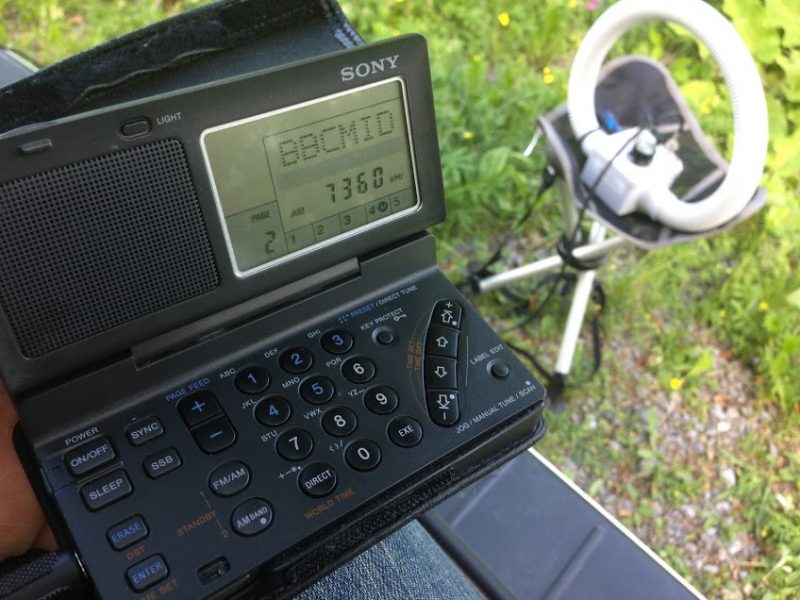
I find that many DSP portables add a “mushy” audio quality to the static found in the noise floor of the receiver. I hear DSP artifacts and that “watery” quality especially if using headphones. No doubt, it’s the DSP simply doing its thing: minimizing background noise and seeking to clarify voice and audio information. But this actually tinkers (or interferes) with my brain’s ability to pull out intelligible information to some degree.
I find I prefer the audio quality of static in analog receivers.
Of course, a bit of this might also be tied to a receiver’s dynamic range and AGC; qualities I also tend to prefer in my benchmark legacy portables.
Does this make any sense?
In truth, this is difficult to explain and, dear reader, I may very well have lost you here. If not, I’m curious what you think.
Do you prefer the audio characteristics of DSP receivers, or legacy receiver architecture? Are there aspects you like of both? Please comment!
Mike Harwood explores active magnetic loop antennas with SDRplay
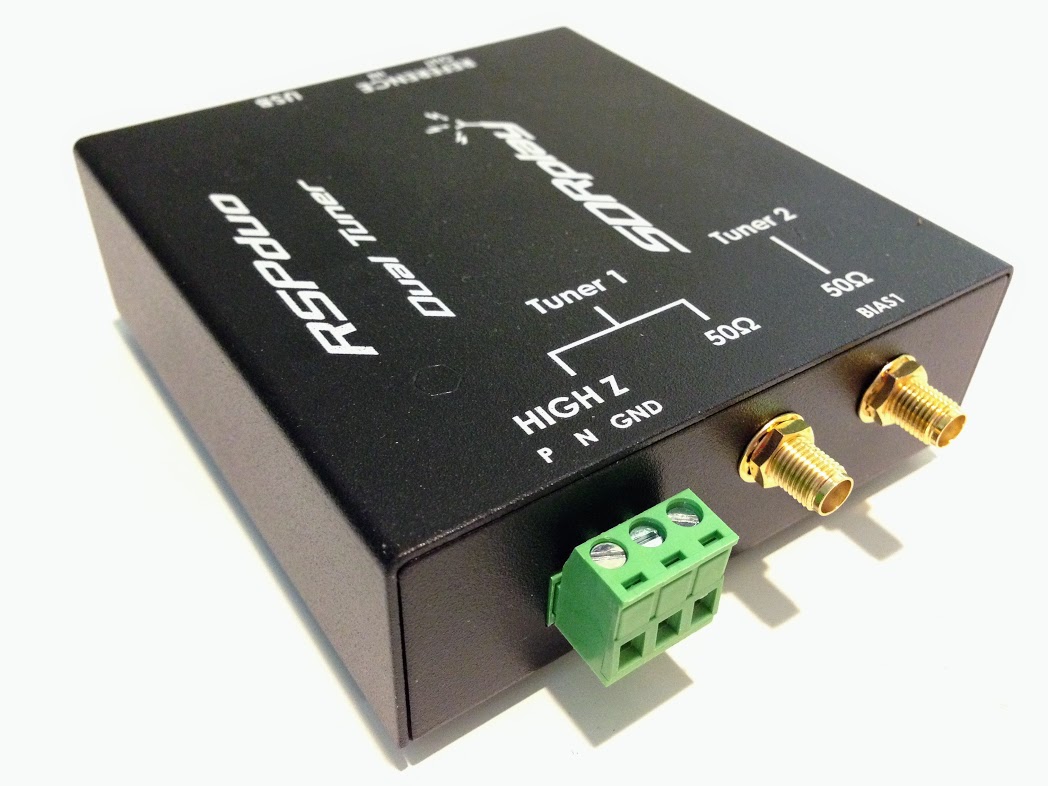 Many thanks to Jon Hudson with SDRplay who shares the following announcement:
Many thanks to Jon Hudson with SDRplay who shares the following announcement:
Introducing a new series of videos comparing the performance of wideband active loop amplifier/antennas for HF frequencies and below. In this introductory video, Mike Harwood shows how an RSPduo enables a real-time comparison of two antennas – in this demo, he uses a Wellbrook 1530AN and one of his own compact loop creations. You can see that he has lined up several other active loop antennas/amplifiers to try in future videos, including the Bonito Megaloop FX, the LZ1AQ amp and the Cross Country Wireless amp.
SDPlay will endorse antennas which work well and formally recommend them on its website antenna suggestions page: https://www.sdrplay.com/antennasuggestions/
This is one of many videos from SDRplay – makers of the RSP family of SDR radios. See the full list of SDRplay videos and applications documents on: https://www.sdrplay.com/apps-catalogue/
The RSP family of SDRs from SDRplay cover 1kHz to 2 GHz with no gaps and give up to 10MHz spectrum visibility.
SDRplay is a UK company. The RSP SDR receivers are made in the UK and can be purchased for worldwide delivery directly from http://www.sdrplay.com/ (click on purchase and select your country to view shipping costs) or you can buy from any of our worldwide resellers listed here: http://www.sdrplay.com/distributors/ Many of the resellers offer local free shipping and/or local language technical support.
The SDRplay YouTube Channel is: https://www.youtube.com/c/SDRplayRSP

